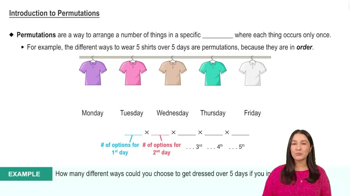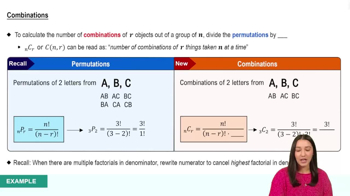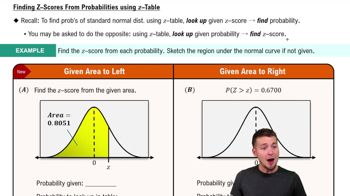1. When you calculate the number of permutations of n distinct objects taken r at a time, what are you counting? Give an example.
Table of contents
- 1. Intro to Stats and Collecting Data1h 14m
- 2. Describing Data with Tables and Graphs1h 55m
- 3. Describing Data Numerically2h 5m
- 4. Probability2h 16m
- 5. Binomial Distribution & Discrete Random Variables3h 6m
- 6. Normal Distribution and Continuous Random Variables2h 11m
- 7. Sampling Distributions & Confidence Intervals: Mean3h 23m
- Sampling Distribution of the Sample Mean and Central Limit Theorem19m
- Distribution of Sample Mean - Excel23m
- Introduction to Confidence Intervals15m
- Confidence Intervals for Population Mean1h 18m
- Determining the Minimum Sample Size Required12m
- Finding Probabilities and T Critical Values - Excel28m
- Confidence Intervals for Population Means - Excel25m
- 8. Sampling Distributions & Confidence Intervals: Proportion1h 12m
- 9. Hypothesis Testing for One Sample3h 29m
- 10. Hypothesis Testing for Two Samples4h 50m
- Two Proportions1h 13m
- Two Proportions Hypothesis Test - Excel28m
- Two Means - Unknown, Unequal Variance1h 3m
- Two Means - Unknown Variances Hypothesis Test - Excel12m
- Two Means - Unknown, Equal Variance15m
- Two Means - Unknown, Equal Variances Hypothesis Test - Excel9m
- Two Means - Known Variance12m
- Two Means - Sigma Known Hypothesis Test - Excel21m
- Two Means - Matched Pairs (Dependent Samples)42m
- Matched Pairs Hypothesis Test - Excel12m
- 11. Correlation1h 6m
- 12. Regression1h 50m
- 13. Chi-Square Tests & Goodness of Fit1h 57m
- 14. ANOVA1h 57m
4. Probability
Counting
Problem 3.4.17
Textbook Question
In Exercises 15-18, determine whether the situation involves permutations, combinations, or neither. Explain your reasoning.
17. The number of ways 2 captains can be chosen from 28 players on a lacrosse team
 Verified step by step guidance
Verified step by step guidance1
Determine whether the order of selection matters in the problem. Since the problem is about choosing 2 captains and the order in which they are chosen does not matter (e.g., Captain A and Captain B is the same as Captain B and Captain A), this situation involves combinations.
Recall the formula for combinations: C(n, r) = n! / [(r!)(n - r)!], where n is the total number of items to choose from, and r is the number of items to choose.
Identify the values of n and r in this problem. Here, n = 28 (the total number of players) and r = 2 (the number of captains to be chosen).
Substitute the values of n and r into the combination formula: C(28, 2) = 28! / [(2!)(28 - 2)!].
Simplify the expression by canceling out the common factorial terms in the numerator and denominator, leaving you with C(28, 2) = (28 × 27) / 2!.
 Verified video answer for a similar problem:
Verified video answer for a similar problem:This video solution was recommended by our tutors as helpful for the problem above
Video duration:
1mPlay a video:
Was this helpful?
Key Concepts
Here are the essential concepts you must grasp in order to answer the question correctly.
Permutations
Permutations refer to the arrangement of items where the order matters. For example, if you are selecting a president and a vice president from a group, the order in which you select them is important, as different roles imply different arrangements.
Recommended video:

Introduction to Permutations
Combinations
Combinations involve selecting items where the order does not matter. For instance, choosing 2 captains from a group of players means that selecting Player A and Player B is the same as selecting Player B and Player A; thus, the arrangement is irrelevant.
Recommended video:

Combinations
Choosing from a Group
When determining how to choose from a group, it's essential to identify whether the selection involves distinct roles or positions. In this case, since the captains are not assigned specific roles beyond being captains, the situation is a combination, as the order of selection does not affect the outcome.
Recommended video:
Guided course

Z-Scores from Probabilities

 7:11m
7:11mWatch next
Master Introduction to Permutations with a bite sized video explanation from Patrick
Start learningRelated Videos
Related Practice
Textbook Question
